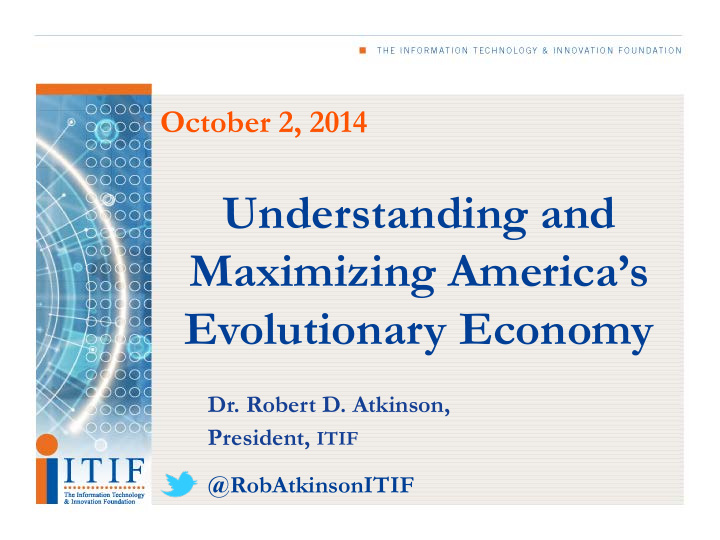



October 2, 2014 Understanding and Maximizing America’s Evolutionary Economy Dr. Robert D. Atkinson, President, ITIF @RobAtkinsonITIF
What Actually is an Economy? A machine that heats up and cools down? 2
What Actually is an Economy? A vast agora for exchanges? 3
An Economy is an Evolutionary System Today: 620 Patents Will be Issued 434 New Products Released 439 New Production Processes Adopted 4
An Economy is an Evolutionary System Today: 3,800 Firms Will Die • • 4,000 Will be Born 5
Net Rates of Firm Birth and Death by Industry, 1993 to 2012
Credit Intermediation Firms Source: Bureau of Labor Statistics
Book, Periodical and Music Stores Source: Bureau of Labor Statistics
Specialty Food Stores
What is Evolutionary Economics? “The essential point to grasp is that in dealing with capitalism we are dealing with an evolutionary process...the fundamental impulse that sets and keeps the capitalist engine in motion comes from the new consumers’ goods, the new methods of production or transportation, the new markets, the new forms of industrial organization that capitalist enterprise creates.” -Joseph Schumpeter, Capitalism, Socialism and Democracy , 82-3. 10
What is Evolution? Improvements in productivity Development of new welfare enhancing products, services, and business models Increases in global competitiveness
But Devolution Can Also Occur Change that makes an economy less vibrant and adaptive.
Three Motive Forces for Economic Evolution
Three Drivers of Economic Evolution Geography Economies are entities that evolve over both time and space. The U.S. used to generate new industries to replace the ones it lost to low wage nations. Competition for leading-edge Real output loss, 2000 to 2010 for selected U.S. evolutionary “replacement manufacturing industries species” is now much stiffer. Source: Bureau of Economic Analysis
Three Drivers of Economic Evolution Technology Despite more resources being devoted to innovation (e.g., global R&D spending is at its peak), innovation in many areas is getting harder, not easier. ICT, is enabling “genetic mutation” in virtually all industries, including the services. Prime examples are the transformations in sectors like media, news, travel services, retail, banking, taxis, hotels, and others.
Technology Driving of Economic Evolution Changes in real industrial output by industry and cause. * 1998-2011 data Source: Bureau of Economic Analysis
Three Drivers of Economic Evolution: Changes in Demand Changes in the types of goods and services demanded by consumers (whether these are businesses, governments or individuals) drive evolution. Various factors can alter the composition of demand, including demographics, culture, and government.
Three Drivers of Economic Evolution: Demand Changes in real industrial output by industry and cause. * 1998-2011 data Source: Bureau of Economic Analysis
Policies to Maximize Evolutionary Growth We need to move beyond the neoclassical and neo-Keynesian playbooks. Markets alone are not enough. Resistance to evolution is neither effective nor welfare enhancing. Using evolutionary economics as a guide, the principles of more effective economic policies become clearer. To maximize evolution, policymakers should:
Policies to Maximize Evolutionary Growth Darwinian and Lamarckian Policies 1. Support global integration; 2. Get out of the way of natural evolutionary gain & loss; 3. Foster a culture that embraces evolution, including natural evolutionary loss; and Limit government barriers to evolution. 4.
Policies to Maximize Evolutionary Growth Intelligent Design Policies 1. Slow down traded sector rate of loss; 2. Enact policies to support organizations to support evolution; 3. Support policies to accelerate economic evolution, especially from technological innovation; and 4. Develop a deeper understanding of the evolution of the U.S. economy.
Conclusion As economies evolve, so too do doctrines and governing systems. Today’s economic policy debate is mostly a reprise of the 70-year-old Keynes-Hayek debate. Time for a “third way:” evolutionary economics.
Thank You Robert D. Atkinson ratkinson@itif.org Follow ITIF www.itif.org @RobAtkinsonITIF www.innovationfiles.org facebook.com/innovationpolicy www.youtube.com/techpolicy
Recommend
More recommend